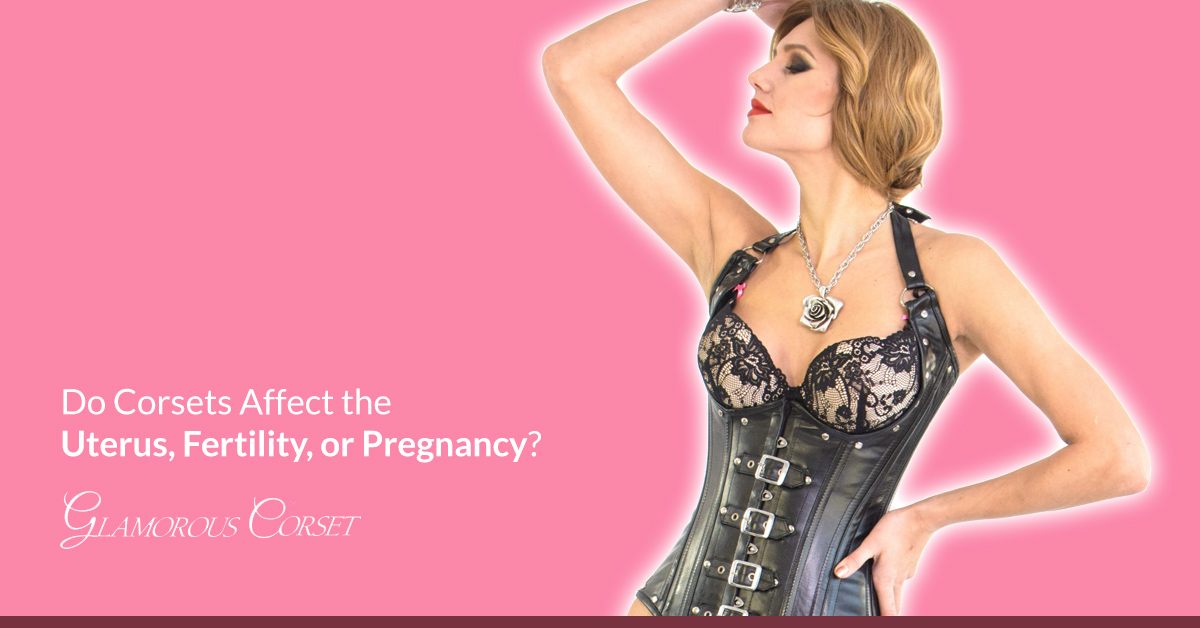Blog
Do Corsets Affect the Uterus, Fertility, or Pregnancy?
Featured Corset: Shane Black Leather Corset
Attitudes regarding what women can and can’t do during pregnancy vary across countries and cultures. For example, some women will have a glass of wine after the first trimester. Others continue to eat sushi and sashimi throughout their pregnancy.
For thousands of years (and even today), nomadic women continued to travel with their tribes and give birth in nomadic dwellings. Today, many women work until a couple of weeks before their due date or until they go into labor.
In other words, you’ll have to figure out what’s right for you when it comes to conceiving, carrying, and birthing your child. If you’re waist training, you might naturally wonder how corset wear could impact your organs, fertility, and gestation. Here we’ll discuss what effect, if any, corsets could have on your ability to conceive and carry your child to term.
What Happens to My Uterus When I Wear a Corset?
All kinds of weird myths exist about corsets strangling your internal organs. However, hundreds of years of women wearing corsets prove otherwise. Like any kind of compression garment, corsets can put some pressure on internal organs. But just like tight jeans or waist cinchers, your corsets aren’t going to cause your uterus extreme or undue harm.
Your uterus won’t shrink, fall out, or close up shop because you’re waist training. No causal link has been found between wearing a corset and suffering a prolapsed uterus. This condition is mainly attributed to age, vaginal delivery, strain (caused by heavy lifting or intense bowel movements, for example), or simple atrophy of the pelvic floor muscles (keep up with those Kegels, ladies).
When you wear a corset, your internal organs may shift slightly, but the good news is that there’s plenty of space for this to occur.
Most people know that our bodies are primarily composed of skin, muscle, fat, and connective tissue overlying the skeleton, with vital internal organs taking up the abdominal and chest cavity.
What you may not know is that there’s also fluid-filled space, called the interstitium, spread throughout the body. It’s under your skin, around muscles and arteries, and in between internal organs.
So when you put on a corset and nip in the waist, your internal organs aren’t really being squeezed—they’re just shifting around to take advantage of unused space. In other words, your womb isn’t going to wander away. Instead, it just migrates a few millimeters.
The 411 on Fertility
When you’re trying to get pregnant, it’s natural to have concerns about potential factors interfering with your baby’s health. And if you waist train, you’ve almost certainly fielded some nosy, ill-informed warnings from those who mistakenly assume this compression garment will somehow impact fertility or conception.
We’re here to set the record straight. Your corset will not stop sperm from reaching eggs in your uterus, prevent fertilized eggs from attaching to the uterine wall, or squeeze an otherwise viable fetus to death before you even know you’re pregnant. So stop worrying!
That isn’t to say you can’t suffer fertility issues due to a wide range of other causes, such as heredity, age, and lifestyle choices. But your corset isn’t likely to be a contributing factor one way or the other. If it were, there would have been a significant decline in population during the Victorian era.
Corsets and Pregnancy: Then and Now
You definitely have to stop wearing your corset during pregnancy, right? No. As a matter of fact, you don’t, but it’s probably a good idea for comfort’s sake if nothing else. Still, let’s go over this undergarment’s history, starting with practices dating back hundreds of years.
During the 18th and 19th centuries, women conceived plenty of children and, despite daily corset-wearing, carried them to term. You may be saying to yourself, “but there were a lot more miscarriages back then.” That’s true. However, those can largely be attributed to health factors like poor diet and limited access to medical care, not to mention less advanced medical practices.
Women were actually expected to continue wearing corsets for the entire duration of their pregnancies. That is because these garments were designed for support and modesty, and polite society required them. Luckily, women didn’t have to squeeze into pre-baby corsets. Instead, they wore maternal corsets with extra lacing on the sides, designed to be loosened as the pregnancy progressed.
While you would never want to wear a waist training corset during pregnancy, you could, if you wished to, wear a maternity corset to support your back and bosom. That said, we wouldn’t recommend it. Alternatively, you’ll find that you can safely get any back support you need with a stretchy belly band designed for this purpose, and you can go back to your beloved corsets following pregnancy.
Note: As each individual’s case is different, we always recommend you consult with your physician for medical advice.
To stay up-to-date with weekly blog posts, waist training tips, and the chance to win one of our monthly corset giveaways, follow us on Facebook, Instagram & subscribe to our mailing list today! Want to find the perfect steel boned corset? Shop some of our favorites: underbust corsets, overbust corsets, corset dresses. You can also shop our corsets by material: cotton corsets, denim corsets, leather corsets, mesh corsets, pvc corsets, and satin corsets. Have questions about getting started with waist training or finding the right size corset? Contact us!

My name is Rachel, I am the owner of Glamorous Corset, a small business founded by me in 2010. Back In 2005, I was in a car accident that left me with a herniated disk. Much to my surprise I learned steel boned corsets were beneficial to several medical injuries including mine. I was always intrigued with corsetry, their history and their beautiful aesthetic. I love sharing knowledge about corsets, educating my wonderful readers and breaking the negative stigma related to corsetry. In combination with my years of research and personal experience I hope my articles are useful and can help anyone who has struggled with some of the same things I have. More about me…


